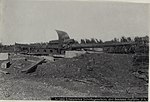Cannone da 152/45
| Cannone da 152/45 | |
|---|---|
 Cannone da 152/45's on pedestal mounts at the Ansaldo factory. | |
| Type | Naval gun Coastal artillery Siege gun |
| Place of origin | Kingdom of Italy |
| Service history | |
| In service | 1917-1945 |
| Used by | Kingdom of Italy |
| Wars | World War I World War II |
| Production history | |
| Manufacturer | Ansaldo |
| Specifications | |
| Mass | Naval gun: 7.1 t (7 long tons) Siege gun: 16.67 t (16.41 long tons) |
| Barrel length | 7.138 m (23 ft 5 in) L/46.7 |
| Shell | Separate loading bagged charge and projectile |
| Shell weight | 47 kg (104 lb) |
| Caliber | 152.4 mm (6 in) |
| Breech | Welin breech block |
| Recoil | Hydro-spring |
| Carriage | Box trail |
| Elevation | -5° to +45° |
| Traverse | Casemate: 60° Siege gun: 10° |
| Rate of fire | 1 rpm |
| Muzzle velocity | 830 m/s (2,700 ft/s) |
| Maximum firing range | 19.4 km (12 mi) |
The Cannone da 152/45 modello 1911 was an Italian naval gun built by the Ansaldo company. It formed the secondary armament of the two Andrea Doria-class dreadnought battleships built during World War I. A number of guns were also converted to siege artillery and coastal artillery roles and served during both world wars.
Variants[edit]
- Coastal artillery - An unknown number of guns were mounted on shielded pedestal mounts as coastal artillery during both world wars.[1]
- Naval artillery - The secondary armament of this class of two ships consisted of sixteen 45-calibre 152-millimetre (6 in) guns, mounted in single casemates along the sides of the hull underneath the main guns.[2] These guns could traverse 60 degrees, depress to −5 degrees and had a maximum elevation of +20 degrees. The gun mounts had a reputation of being wet in heavy seas and when the ships were modernized these gun positions were removed and the surplus guns were redeployed.[3]
- Siege artillery - This version consisted of mounting surplus barrels on a large box trail carriage to address the Italian Army's need for siege artillery and long-range counter-battery work. The carriage had a large open section in the middle that allowed the gun to reach high elevation angles. In order to deploy the guns, a large pit had to be dug to allow the breech to recoil and also allowed the gun crew to service the breech. At the front of the pit, there was a platform to anchor the gun, allowing for limited traverse. 53 were in Italian service in 1939 mostly in Northern Italy. The German designation for the gun was the 15.2 cm K 411(i).[4]
Photo Gallery[edit]
Wikimedia Commons has media related to Cannone da 152/45.
-
A 152/45 at Monte Sabatino in 1917.
-
A 152/45 captured by Austro-Hungarian forces.
-
A 152/45 on its firing platform
References[edit]
- ^ "2170 – CANNONE da 152/45 S. 1911 per postazioni a terra | Associazione Navimodellisti Bolognesi". www.anb-online.it (in Italian). Retrieved 1 July 2018.
- ^ Friedman, Norman (2011). Naval weapons of World War One : guns, torpedoes, mines and ASW weapons of all nations : an illustrated directory. S. Yorkshire: Seaforth Pub. p. 240. ISBN 9781848321007. OCLC 751804655.
- ^ Gardiner, Robert (1985). Conway's All the World's Fighting Ships 1906–1921. Gray, Randal. Annapolis, Md.: Naval Institute Press. p. 260. ISBN 0870219073. OCLC 12119866.
- ^ Chamberlain, Peter (1975). Heavy artillery. Gander, Terry. New York: Arco. ISBN 0668038985. OCLC 2143869.



